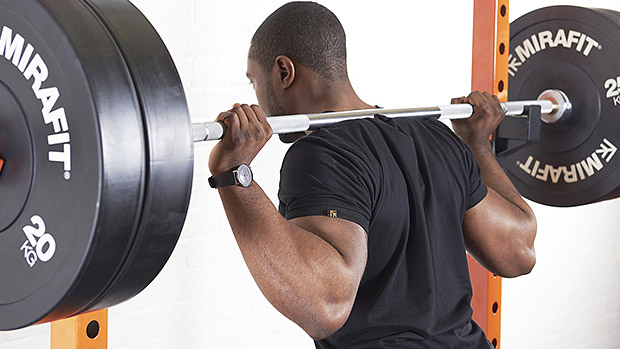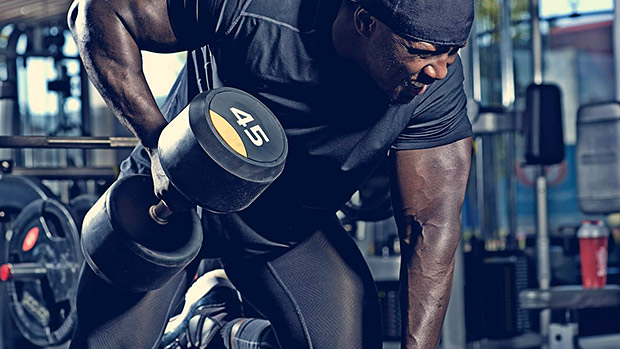Want to get stronger and build more muscle while spending less time in the gym? Then train more efficiently and throw out the garbage work. Here are nine ways to do it.
If you carefully analyze your training, you'll find that the majority of your results are due to a relatively small number of effective exercises. The rest of your exercises add a bit, but not as much as you might think.
To identify your best exercises, start by asking yourself, "If I could only do one exercise, based on my needs and goals, what would it be?" Write it down. I know as a serious lifter, you'd never do just one exercise, but stay with me. Then ask, "If I could only do two exercises, what would they be?" Continue this process until you have your top ten exercises.
Now this doesn't mean that you only do these exercises. You can also add anything else you want, as time permits. You can also switch out any exercise for a similar variation if your results dry up or your joints get cranky. However, when you're short of time, you cut the other stuff, but you guard your top ten exercises.
If things ever got so crazy that you couldn't do even these ten exercises, you can reduce the list as needed, starting at number ten and working down.
Too many people approach training as if they're artists. For example, a movie director will demand take after take until a scene is perfect. The same is true for a musician recording a new album in the studio. Artists seek perfection regardless of the time it takes.
Unless you're being paid to train (a physique star or professional athlete), you should think like an investor. An investor knows that he has a limited amount of resources to invest. As a result, an investor constantly asks the question, "What is the ROI (return on investment) on this?" An investment opportunity that yields a 1% return is of no interest to a serious investor.
If you're serious about training, you need to demand a high ROI on every minute you invest into it. To apply this mindset, start by measuring the fitness, performance and/or body composition variables that are most important to you. Then start experimenting with slight changes to singular variables and track your results. Here are some examples:
- Number of training days per week: Try adding or subtracting a day.
- Exercises: Try adding or subtracting a few exercises.
- Number of sets: Try adding or subtracting a set from each of your main exercises.
As you gather data from your experiments, reflect on your findings. Did cutting something out still allow you to make good progress? Did adding something lead to significantly greater results? Is that extra investment of time worth it for you right now?

Deep down inside we want it all. We want to look like our favorite physique star, have the explosive athleticism of an NFL running back, and put up numbers in the gym that would embarrass the guys at Westside. Too bad you can't have it all, especially when time is limited. When life gets busy, you need to trim the fat.
Ask yourself, "What's my top training priority right now?" Then, apply a laser-like focus on this priority in your programming. For example, if your goal for this block of training is building muscle, look at everything in your program and ask, "Will this help me build muscle?" If the answer is no, severely reduce it to maintenance level or temporarily cut it out.
Research shows that training a muscle twice per week is superior to once per week, but the merits of training it any more frequently are up for debate (1). Thankfully, for the busy lifter, recent studies also show that you have more flexibility here than you might think.
A 2015 study using elite bodybuilders compared an equal-volume, two-way split done four times per week for four weeks to a 3-day split done six days per week (2). Both groups saw similar increases in size and strength.
A more recent study compared equal training volume spread out over two days (Monday and Thursday) or four days (Monday, Tuesday, Thursday, and Friday) (3). After six weeks of training, both groups improved performance and lower body mass and the two-day per week group improved upper body size and body composition.
Yet another study compared training three times vs. six times per week with equal training volume and intensity (4). After six weeks of training, both groups had significantly increased their maximum strength and lean muscle mass.
How to use this info: Look at your busy schedule. Is it easier to have longer, less frequent sessions or to train with shorter, more frequent training sessions? As long as you get in the work you need, you can use the weekly schedule that suits you best.
If you have a crazy schedule, you might find it difficult to hit the gym on the same days each week. This can pose a problem if your training schedule is inflexible.
For example, if you do whole-body training on Monday, Wednesday, and Friday, what happens if you can't train on Monday? If you're doing a bro split and training one body part per day, missing a workout means you miss that body part for another whole week.
For more flexibility, split your body into two, non-overlapping A and B sessions. You could do upper/lower, push/pull or hinge+push/squat+pull. This allows you to train back-to-back days while hitting different muscle groups.
If you're more advanced, use two different A and B sessions (i.e., A1, B1, A2, B2) with different exercises and different rep ranges. Then simply rotate through the days as your schedule allows.
For example, your normal training week might look like this:
- Monday: A1
- Tuesday: B1
- Thursday: A2
- Friday: B2
By using the above strategy, missing a training day isn't a problem. You can easily make up the missed day because your A and B training sessions don't interfere with each other. You can also just reschedule a training day to the next day and keep your normal weekly training days. Here's an example of each option:
Option 1 – Catch-up
- Monday: Can't train
- Tuesday: A1
- Wednesday: B1
- Thursday: A2
- Friday: B2
Option 2 – Continue the Cycle
- Monday: Can't train
- Tuesday: A1
- Thursday: B1
- Friday: A2
- Next Monday: B2
When you're pressed for time, you'll be tempted to cut your rest intervals short. Resist the urge! While it may seem like a time-saver, it's actually a results-killer.
Consider that research shows that 3 minutes between sets is optimal for gaining strength and size (5), so when you short-change your rest times, you reduce the amount of weight you can lift and/or reps for your subsequent sets. As a result, you lower your volume load and decrease your gains.
Instead of using insufficient rest intervals, try the late Charles Poliquin's method of alternating between non-competing exercises. This system has been around for a long time, yet few people use it. That's too bad, because when done correctly, you can cut your training time in half.
Instead of doing a set of bench press and then playing around on your phone for 3 or 4 or more minutes, place a heavy dumbbell next to the bench press. Then do this:
- A1. Bench Press: Rest 45 seconds
- A2. 1-Arm Dumbbell Row: Rest 45 seconds
- Repeat for your desired number of rounds
If you prefer whole body training, you can also pair lower body hinge movements with upper body movements:
Hinge and Push Example
- A1. Trap Bar Deadlift: Rest 60 seconds
- A2. Dips: Rest 45 seconds
Squat and Pull Example
- B1. Front Squat: Rest 60 seconds
- B2. Chin-Up: Rest 45 seconds
This style of training only gives you time to record your set in your training journal, grab a quick swig of water, and get ready for your next set. This keeps you off your phone, which will improve your mental focus and create a better flow to your training session.

Have you ever made fun of those guys with massive upper bodies and scrawny legs? We all have. While lousy legs can be due to a fear of hard work and an aversion to the squat rack, genetics can also play a roll.
Some lifters naturally have more of a light bulb build – big on top and small from the waist down. Others naturally have more of a Christmas tree build where their lower bodies are disproportionately more muscular than their upper bodies.
When you're pressed for time, skimp on your strengths. If you inherited cows instead of calves from your parents, you'll look great in shorts, even with no direct calf work. If you have naturally big arms, you can skip direct arm work when time is tight. Always prioritize your big bang, multi-joint exercises. If you still have a small amount of time left, go ahead and use it to address your genetic weaknesses.
Lots of busy folks use circuit training to get in and out of the gym fast. While this works great for those with modest fitness goals, circuit training is problematic for serious lifters. For one thing, it's hard to set up multiple big lifts in a busy gym. In addition, when you're moving respectable weight, the systemic fatigue from circuit training reduces your volume load.
However, accessory exercises cause minimal systemic fatigue. When you run these exercises in a circuit, you can pack a lot of quality work into a very short amount of time. Here are two examples:
Lower Body Accessory Circuit
- A1. Calf Raise: No rest
- A2. Ab Exercise: No rest
- A3. Neck Work: No rest
- A4. Upper Trap Work: No rest
- Do 2-4 rounds
(Yes, I know trap and neck work aren't "lower body," but I like to include them on lower body days since the traps already get hit on so many big leg movements.)
Upper Body Accessory Circuit
- A1. Biceps Curl: Rest 20 seconds
- A2. Face Pull: Rest 20 seconds
- A3. Lateral Dumbbell Raise: Rest 20 seconds
- A4. Triceps Extension: Rest 20 seconds
- Do 2-4 rounds
Another option is to skip doing accessory work at the gym. Just do your big lifts and get out. Then, later at home, do some accessory work with bands, body weight exercises, and adjustable dumbbells.
Back in the 70's, Arthur Jones convinced many people that HIT (high intensity training) was a superior way to train. He'd take people who were used to doing a high volume of training (the popular style of training at that time, thanks to Arnold) and transition them to short, brutal training sessions.
People would see a short-term spike in strength and muscle mass and Arthur would gain another HIT disciple. The truth is that Arthur didn't "prove" that HIT was superior. Instead, he demonstrated that following up a higher-volume program with a sudden drop in volume leads to a short-term, supercompensation effect. It can also save you some time in the gym.
While there are genetic outliers who seem to be able to get bigger and stronger doing a 12-minute HIT workout once every 4 days, most of us will need more volume than that – at least some of the time. That's where periodization comes in. However, instead of following a rigid 12-week plan, you can apply the same concept to a flexible periodization plan that works with your busy life:
- Normal busy life: Make steady gains in strength and muscle doing moderate-volume training. Don't get psyched up or start cracking ammonia caps. Just get in some hard work on some effective exercises. Examples: 5x5, 4x6-8.
- Time is even more restricted: When things are even more hectic than usual, drop your volume down a bit but increase your intensity. You can do this for the occasional training session or you can apply it for a few weeks at a time. If you put your time in with moderate volume training, the change will give you a nice spike in strength and muscle mass. For example, do sessions of 3x5, or 2x6-8.
You can occasionally slip in an intensity technique such as forced reps, drop sets, or rest-pause training, but be careful not to overdo these as they can burn you out quick.
- Life is insane: Never forget that training is a stress. To avoid injuries, burn out, and unnecessary plateaus, keep training stress inversely related to life stress. If you have an insanely busy week, don't try to be a hero and push through your normal routine in the gym. Don't try to bomb and blitz your muscles with over-the-top intensity techniques, either. Instead, deload (drop volume, frequency, and intensity) or devote a few days or a week to active rest (get outside and enjoy restorative physical activity).
- Schoenfeld BJ et al. Effects of Resistance Training Frequency on Measures of Muscle Hypertrophy: A Systematic Review and Meta-Analysis. iew Sports Med. 2016 Nov;46(11):1689-1697. PubMed.
- Ribeiro AS et al. Effect of Two- Versus Three-Way Split Resistance Training Routines on Body Composition and Muscular Strength in Bodybuilders: A Pilot Study. Int J Sport Nutr Exerc Metab. 2015 Dec;25(6):559-65. PubMed.
- Yue FL et al. Comparison of 2 weekly-equalized volume resistance-training routines using different frequencies on body composition and performance in trained males. Appl Physiol Nutr Metab. 2018 May;43(5):475-481. PubMed.
- Colquhoun RJ et al. Training Volume, Not Frequency, Indicative of Maximal Strength Adaptations to Resistance Training. J Strength Cond Res. 2018 May;32(5):1207-1213. PubMed.
- Schoenfeld BJ et al. Longer inter-set rest periods enhance muscle strength and hypertrophy in resistance-trained men. J Strength Cond Res. 2016 Jul;30(7):1805-12. PubMed.




